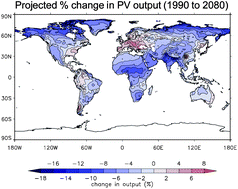Building large solar power plants requires significant long-term investment so understanding impacts from climate change will aid financial planning, technology selection, and energy output projections. In this article we examine how projected changes in temperature and insolation over the 21st century will affect photovoltaic (PV) and concentrated solar power (CSP) output. Projected climate data was obtained from the coupled ocean-atmosphere climate models HadGEM1 and HadCM3 under the IPCC SRES A1B scenario which describes a future world of rapid economic growth with a balanced use of renewable and fossil fuel power generation. Our calculations indicate that under this scenario PV output from 2010 to 2080 is likely to increase by a few percent in Europe and China, see little change in Algeria and Australia, and decrease by a few percent in western USA and Saudi Arabia. CSP output is likely to increase by more than 10% in Europe, increase by several percent in China and a few percent in Algeria and Australia, and decrease by a few percent in western USA and Saudi Arabia. The results are robust to uncertainty in projected temperature change. A qualitative analysis of uncertainty in projected insolation change suggests strongest confidence in the results for Europe and least confidence in the results for western USA. Changes in PV and CSP output are further studied by calculating fractional contributions from changes in temperature and insolation. For PV there is considerable variation in contribution depending on location. For CSP the contribution from changes in insolation is always dominant.

You have access to this article
 Please wait while we load your content...
Something went wrong. Try again?
Please wait while we load your content...
Something went wrong. Try again?


 Please wait while we load your content...
Please wait while we load your content...